*On June 1, 2023 Emerson’s Climate Technologies business became a new standalone company – Copeland. Though our name has changed, we are building on more than a century of HVACR innovation and industry leadership, and Copeland continues to offer the same products, industry stewardship, and learning opportunities you’ve grown to trust. Information found on this webpage posted before June 1, 2023 may contain our old name or branding, but you can be at ease knowing it was created with the knowledge and expertise of Copeland.
In October, the Environmental Protection Agency (EPA) issued a final decision on its Technology Transitions Rule, establishing a federal framework for the phasedown of hydrofluorocarbon (HFC) refrigerants in new equipment under the authority of the American Innovation and Manufacturing (AIM) Act. The rule sets limits on HFCs in specific HVACR sectors and subsectors, including supermarket commercial refrigeration, AC and heat pumps.

The Technology Transition Rule was eagerly anticipated by HVACR industry stakeholders who had closely followed the EPA’s proposal since it was announced in late 2022. The EPA reviewed industry-wide feedback in the formation of this final rule, which considered the current refrigerant options, technological impacts and feasibility of transitioning to lower global warming potential (GWP) alternatives, per each individual sector.
As a result, GWP limits — of 150, 300 or 700 — were set only if refrigerant alternatives were available to support the transition in the near term. In other sectors, the EPA prohibited (i.e., delisted) the use of some legacy higher-GWP HFC refrigerants, while still allowing the use of select lower-GWP A1 (i.e., non-flammable) alternatives.
The EPA also set compliance dates, defined by either manufacture or installation date. Factory-charged, self-contained products have been assigned a specific manufacture compliance date, while field-charged, -assembled and -installed systems have a designated installation compliance date. From an ease of compliance standpoint, the installation methodology may introduce some unexpected complexities.
Per the EPA, manufacture is defined as such: “to complete the manufacturing and assembly processes of a product or specified component such that it is ready for initial sale, distribution or operation.” The term install is defined as “to complete a field-assembled system’s circuit, including charging with a full charge, such that the system can function and is ready for use in its intended purpose.”
Self-contained, packaged products have a sell-through date of three years. Field-installed systems — which may be composed of assemblies of new and used components — have no allowable sell through date. For manufacturers of systems that are developed, rated and sold only as a matched set (i.e., as in some residential split HVAC), there is a risk that inventories could be stranded after the install date. However, condensing units and indoor evaporator units can continue to be sold as components using existing refrigerants if they aren’t installed at the same time.
Compliance is determined per sector, with some sectors including both systems and products, as follows.
AC
Systems
- Stationary residential and light commercial AC and heat pumps (e.g., mini-splits, unitary split systems): 700 GWP limit with an installation compliance date of Jan. 1, 2025
- Stationary variable refrigerant flow AC and heat pumps: 700 GWP limit with an installation compliance date of Jan. 1, 2026
- Data centers, computer room AC and information technology equipment cooling: 700 GWP limit with an installation compliance date of Jan. 1, 2027
Products (self-contained)
- Stationary residential and light commercial AC and heat pumps (e.g., window units, portable room AC): 700 GWP limit with a manufacture/import compliance date of Jan. 1, 2025
- Data centers, computer room AC and information technology equipment cooling: 700 GWP limit with a manufacture/import compliance date of Jan. 1, 2027
Chillers
Systems
- Industrial process refrigeration with exiting fluid below -50 °C (-58 °F): not covered
- Industrial process refrigeration with exiting fluid below -50 to -30 °C (-58 to -22 °F): 700 GWP limit with an installation compliance date of Jan. 1, 2028
- Industrial process refrigeration with exiting fluid above -30 °C (-22 °F): 700 GWP limit with an installation compliance date of Jan. 1, 2026
- Comfort cooling: 700 GWP limit with an installation compliance date of Jan. 1, 2025
- Ice rinks: 700 GWP limit with an installation compliance date of Jan. 1, 2025
Products (self-contained)
- Industrial process refrigeration with exiting fluid below -50 °C (-58 °F): not covered
- Industrial process refrigeration with exiting fluid below -50 to -30 °C (-58 to -22 °F): 700 GWP limit with a manufacture/import compliance date of Jan. 1, 2028
- Industrial process refrigeration with exiting fluid above -30 °C (-22 °F): 700 GWP limit with a manufacture/import compliance date of Jan. 1, 2026
- Comfort cooling: 700 GWP limit with a manufacture/import compliance date of Jan. 1, 2025
- Ice rinks: 700 GWP limit with a manufacture/import compliance date of Jan. 1, 2025
Retail food refrigeration
Systems
- Retail food supermarket rack systems (> 200 lbs of charge): 150 GWP limit with an installation compliance date of Jan. 1, 2027
- Retail food supermarket rack systems (< 200 lbs of charge): 300 GWP limit with an installation compliance date of Jan. 1, 2027
- Retail food remote condensing units (> 200 lbs of charge): 150 GWP limit with an installation compliance date of Jan. 1, 2026
- Retail food remote condensing units (> 200 lbs of charge): 300 GWP limit with an installation compliance date of Jan. 1, 2026
- Retail food remote condensing units (high-temperature side of cascade system): 300 GWP limit with an installation compliance date of Jan. 1, 2026
- Remote refrigerated food processing and dispensing equipment: cannot use any of the 38 restricted refrigerants and an installation compliance date of Jan. 1, 2027
Products (self-contained)
- Self-contained refrigeration: 150 GWP limit as of Jan. 1, 2025
- Food processing and dispensing equipment (< 500 grams of charge): 150 GWP limit with a manufacture/import compliance date of Jan. 1, 2027
- Food processing and dispensing equipment (> 500 grams of charge): cannot use any of the 38 restricted refrigerants and a manufacture /import compliance date of Jan. 1, 2027
- Ice cream makers (within the scope of UL 621, 7th edition): cannot use any of the 38 restricted refrigerants and a manufacture/import compliance date of Jan. 1, 2027
Automatic commercial ice machines (ACIMs)
In self-contained and remote ACIMs, compliance is determined by the ice production method (i.e., batch or continuous) and daily harvest volumes.
Systems
- Remote ACIMs: cannot use any of the 21 restricted HFCs specified in the rule and an installation compliance date of Jan. 1, 2027
Products (self-contained)
- Self-contained ACIMs of smaller volumes (≤ 1,000 lbs of batch type; ≤ 1,200 lbs of continuous type): 150 GWP limit and a manufacture/import compliance date of Jan. 1, 2026
- Self-contained ACIMs of higher volumes (> 1,000 lbs of batch type; > 1,200 lbs of continuous type): cannot use any of the 38 restricted HFCs specified in the rule and a manufacture/import compliance date of Jan. 1, 2027
Cold storage warehouses
Systems
- Cold storage warehouses (> 200 lbs of charge): 150 GWP limit and an installation compliance date of Jan. 1, 2026
- Cold storage warehouses (< 200 lbs of charge): 300 GWP limit and an installation compliance date of Jan. 1, 2026
- Cold storage warehouses (high-temperature side of cascade system): 300 GWP limit and an installation compliance date of Jan. 1, 2026
Products (self-contained)
- Cold storage warehouses (> 200 lbs of charge): 150 GWP limit and a manufacture/import compliance date of Jan. 1, 2026
- Cold storage warehouses (< 200 lbs of charge): 300 GWP limit and a manufacture/import compliance date of Jan. 1, 2026
- Cold storage warehouses (high-temperature side of cascade system): 300 GWP limit and a manufacture/import compliance date of Jan. 1, 2026
Refrigerated transport
Systems
- Intermodal containers with refrigerant temperature entering the evaporator below -50 °C (-58 °F): not covered
- Intermodal containers with refrigerant temperature entering the evaporator ≥ -50 °C (-58 °F): 700 GWP limit and an installation compliance date of Jan. 1, 2025
- Road and marine products: cannot use any of the 21 restricted HFCs specified in the rule and an installation compliance date of Jan. 1, 2025
Products (self-contained)
- Intermodal containers with refrigerant temperature entering the evaporator below -50 °C (-58 ° F): not covered
- Intermodal containers with refrigerant temperature entering the evaporator ≥ -50 °C (-58 °F): 700 GWP limit and a manufacture/import compliance date of Jan. 1, 2025
- Road and marine products: cannot use any of the 21 restricted HFCs specified in the rule and a manufacture/import compliance date of Jan. 1, 2025
Industrial process refrigeration (not using chillers)
Systems
- Industrial process refrigeration with ≥ 200 lbs or refrigerant and refrigerant temperature entering the evaporator > -30 °C (-22 °F): 150 GWP limit with an installation compliance date of Jan. 1, 2026
- Industrial process refrigeration with < 200 lbs of refrigerant and refrigerant temperature entering the evaporator > -30 °C (-22 °F): 300 GWP limit with an installation compliance date of Jan. 1, 2026
- Industrial process refrigeration, high side of cascade system with refrigerant temperature entering the evaporator > -30 °C (-22 °F): 300 GWP limit with an installation compliance date of Jan. 1, 2026
- Industrial process refrigeration with refrigerant entering the evaporator from -50 to -30 °C (-58 to
-22 °F): 700 GWP limit with an installation compliance date of Jan. 1, 2028 - Industrial process refrigeration with refrigerant entering the evaporator below -50 °C (-58 °F): not covered
Products (self-contained)
- Industrial process refrigeration with refrigerant entering the evaporator ≥ -50 °C (-58 °F) and < -30 °C
(-22 °F): 700 GWP limit with a manufacture compliance date of Jan. 1, 2028 - Industrial process refrigeration, high side of cascade system with refrigerant temperature entering the evaporator ≥ -30 °C (-22 °F): 300 GWP limit with a manufacture compliance date of Jan. 1, 2026
- Industrial process refrigeration with < 200 lbs of refrigerant and refrigerant temperature entering the evaporator ≥ -30 °C (-22 °F): 300 GWP limit with a manufacture compliance date of Jan. 1, 2026
- Industrial process refrigeration with ≥ 200 lbs or refrigerant and refrigerant temperature entering the evaporator ≥ -30 °C (-22 °F): 150 GWP limit with a manufacture compliance date of Jan. 1, 2026
- Industrial process refrigeration with refrigerant entering the evaporator below -50 °C (-58 °F): not covered
In addition to the new ruling, the EPA has released an HFC Refrigerant Management proposal that seeks to enforce HFC refrigerant management requirements that are similar, albeit more aggressive, than its previous Section 608 provision for ozone depleting substances (ODS). The proposal calls for leak repairs on existing systems, refrigerant recovery and reclamation standard compliance, and automatic leak detection on new and existing equipment installations containing more than 1,500 lbs of refrigerant. In addition, the EPA has proposed the use of reclaimed HFCs in several sectors, for initial charge and/or for use in service.
By establishing GWP limits and HFC restrictions per sector — and proposing new refrigerant management requirements — the EPA is attempting to balance the demand relative to the reduction in supply of HFCs under the AIM Act. To learn more about the dynamic regulations impacting HVACR, please visit Copeland’s content hub. Stay tuned for a new webinar that will further explain the latest regulatory developments.
**The guidance in this article is intended to be general in nature and is not to be conveyed as legal advice regarding the regulations discussed herein. To ensure compliance with all aspects of the discussed regulations, please consult with an attorney and/or other experts as maybe appropriate.

8 proven strategies for rigorous cold chain management
Preparing for the approval and safe use of A2Ls in commercial refrigeration applications...
Protection for high-value shipments just got even better
We’re excited to announce the release of Copeland’s newest real-time tracker, the GO Real-Time...

Three proven strategies to prevent cargo theft
The over-the-road (OTR) transport industry is experiencing a surge in cargo thefts. As thieves...
